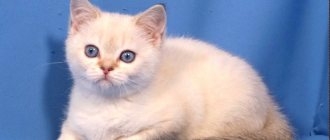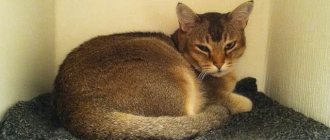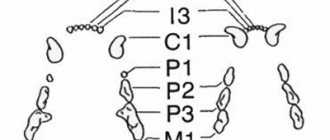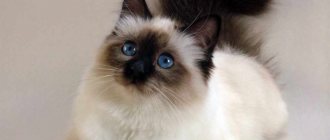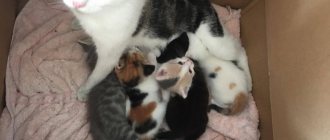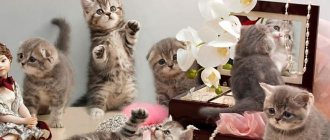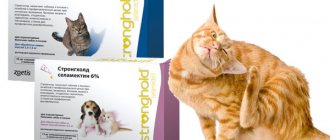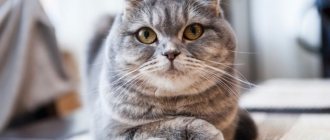History of the origin of the Siberian cat
The exact date when these cats appeared in Siberia is unknown. The first mention of cats that looked similar to modern Siberians and were called Bukhara cats dates back to the 16th century. Presumably they arrived with Russian settlers from trade trips to Asian countries, and quickly spread throughout the Russian Empire. At that time, long-haired beauties were valued primarily as excellent rodent hunters.
The breed was formed in the Urals and east of the Urals. Also, it is very common in the north of the European part of Russia, in the central and western regions of the country.
Another version of the origin of the Siberian breed suggests that Siberians are an aboriginal cat descended from wild cats, perhaps even from manul cats. But felinologists consider this version unconfirmed.
Disputes about who is the ancestor of Siberian cats are still ongoing. This breed is very similar to the Norwegian Forest Cat, but there are no related connections between them. Simply similar living conditions and climate endowed both breeds with thick hair, love of freedom and hunting habits.
Norwegian Forest Cat
Siberian cat
External characteristics of Siberian cats
The fluffy Russian beauty has a harmonious and attractive appearance:
- Wool. Fine texture, soft to the touch undercoat, but with a high degree of density. The fur of a Siberian cat has such features. The hairs are distributed smoothly from the neck and back, fall to the sides and extend to the tail. On top, the wool repels water and shines. In summer it is shorter. During the hot season, the Siberian cat looks like a smooth-haired cat. The volume remains only in the tail area. In winter, the pet has a chic collar, the tail increases in circumference even more, and “pants” are visible on the hind legs.
- Tail. Has medium length. It looks like the tail of a large raccoon. It has a wide base, gradually tapers towards the end and is rounded.
- Neck. Powerful and strong. A wide fluffy caftan forms around it. The cat also has impressively sized shoulders.
- Head. Looks like a trapezoid with rounded corners. At the ends of the ears there are small brushes, like those of a lynx. There is a smooth transition from the nose to the forehead, and not flattened like the Persians. The eyes of Siberians are medium-sized, oval, slightly slanted. Expressive and evenly colored pupils.
- Body and legs. The body of the Siberian breed is proportional. The body is of medium length. It is massive, slightly elongated. The chest is voluminous, the neck is wide, the back is dense and powerful. Paws are medium in length, thick, muscular. Tufts of hairs stick out between the toes on the rounded paws.
The lordly appearance of Siberian cats is in harmony with their temperament and character. They grow to medium size and are quite heavy. Males grow up to 40 cm in length, and females - up to 30 cm. The young quickly gain weight. Males grow up to 8-10 kg, and cats - up to 5-7 kg.
Description of the breed
Standard
Description of the appearance and character of the breed, according to the MAO, as well as signs of defects.
| Body |
|
| Head |
|
| Wool |
|
| Color |
|
Disadvantages of the breed / marriage
According to the standard, the following traits are not allowed in representatives of the Siberian breed:
- Body : elongated, overly slender body with light bones. Thin legs with small paws. Long neck. Tail that is short or longer than the body and has insufficient hair.
- Head : narrow muzzle with thin cheeks; flat profile, like Persian cats. Small eyes. Ears too big or small.
- Coat : lack of undercoat and tufts of hair between the toes. Cover coat lacking shine.
Appearance
Siberian cat: description of the breed
A native of forests, the Siberian cat looks like a wild animal. Strong muscles, thick hair, tufts on the ears and paws are the characteristic features that distinguish this breed from the rest.
Signs of purebred Siberians:
Kurilian Bobtail
Turkish Angora
Pied Cat
- The head is trapezoidal, small, proportional to the body, with a massive neck at the base.
- The body has a developed muscular system, the weight is large - from 4 to 12 kg.
- The paws are large, strong, rounded, with hair between the toes.
- The tail is voluminous at the base, tapering towards the end. The length of the tail is less than the size of the rest of the body.
- The ears are medium-sized, set wide apart, rounded at the top and tufted at the tips. The inside of the ears is covered with fur.
- The eyes are large, expressive, shades from light to brown. Eyes with green irises are especially valued by breeders.
- The coat is long, thick, with a double undercoat, and has water-repellent properties. There is a collar of fur on the neck, which becomes invisible in the autumn-spring period due to molting.
- The color of purebred Siberian cats cannot be lilac, spicy cinnamon, fawn. Standard colors are allowed, both plain and with ornaments.
It is believed that thick, long hair is the enemy of allergy sufferers. For Siberian cats the opposite is true; their luxurious hair is hypoallergenic. These animals do not develop mats of fur; the combing procedure is carried out only to remove excess hair.
A rich range of shades allows you to choose a pet to your liking.
Existing colors:
- Neva Masquerade - stands out for its color-point color and bright blue eyes;
- black brindle - with stripes on the back and belly, as well as with the classic letter “M” on the forehead;
- marbled - similar to brindle, distinguished by large circles on the sides and “butterflies” on the shoulders;
- black spotted - with clear black spots on the sides;
- striped - there are stripes on the tails and paws, but there are no stripes on the rest of the body;
- chinchilla - notable for its hair color: white at the base, black at the tips, the color is considered rare;
- smoky – there are several shades of smoke: black, blue, red; This color is also distinguished by a bright white undercoat;
- tortoiseshell – black and red color, eyes are usually dark yellow;
- silver – superficially colored, and the undercoat is completely white;
- golden – with a tint of beige-golden color.
Russian Blue cat: description of the breed
The Russian Blue cat is a short-haired cat. This species has an elegant grace and plush coat in silvery iridescent shades.
Breed parameters:
- average weight from 2 to 6 kg;
- height is short, up to 25 cm at the withers;
- color is solid blue-gray without spots or stripes;
- expressive, green eyes;
- nose and paw pads are plain, black;
- the ears are erect and pointed, with almost no hair inside;
- the tail is long, pointed;
- The main coat and undercoat are the same length; at the ends the coat is lighter and silvery.
Photos of Siberian cat colors
Black
Ginger
Blue
Cream
Color point
Seal Point
Red point
Blue Point
Tortoiseshell
Tortoiseshell with white
Smoky
Silver
Marbled Tabby
brindle tabby
Spotted Tabby
Gold
Character of Siberians
They are affectionate, but reserved, towards people. The Siberian cat will not ask to be held, but at the same time they will not leave the owner when he is ill. This breed is suitable for those who work a lot or are away from the apartment for a significant part of the day.
Attachment to the owner and family gets along with a proud and independent character. Quiet and unobtrusive cats, however, will not refuse to play with a family member. A pet can use anything that seems interesting to him as a toy.
Important! Siberians are proud and cannot tolerate sudden affection from their owners.
They love to watch what is happening from above, so you should not be surprised if you find this representative of the feline on cabinets, refrigerators, bookshelves and even on a chandelier.
The Siberian cat is an excellent hunter; it is capable of catching not only a mouse, but also a rabbit and a rat. Rest assured that a private house and its territory will be under reliable protection. She will happily bring a hunting trophy to her owner, which even reminds her of a dog.
These cats are brave protectors. They will protect the place that they consider theirs, keeping strange animals and people away. And they will definitely inform the owners about them. Siberians are not afraid of dogs or strangers, but they remain wary around them until they are sure of their safety.
Possible problems
Although the wool of the Siberian breed is considered hypoallergenic, this does not exclude the risk of developing allergies in family members prone to it. So, if in doubt, you should visit a doctor and do a test for yourself and those who live with you.
The second point is the required time to care for long hair. If you are not ready to brush your cat 1-2 times a week, and during the shedding period every other day or every day, then it is better to take a closer look at short-haired or hairless breeds. And yes, there will be wool everywhere and always, just like from any long-haired breed.
How to care for the breed
Cats need the following hygiene procedures:
- Brushing the coat 2 times a week. This protects your pet from getting fur balls into the esophagus.
- Trimming nails. You can replace it by buying scratching posts.
- Bathing once every three months.
- Ear cleaning.
- Care for the eyes and surrounding area.
The Siberian cat is a hunter. If possible, she will get her own food - for example, in a country house or in a private house. But in urban conditions, you need to feed your pet with dry ready-made food of premium quality. When eating natural foods, you should definitely include vitamin supplements in your diet.
How to choose a Siberian kitten
First of all, you should understand why you want to get a kitten of this breed. If you need a good companion or hunter, you should take a kitten whose parents do not have high titles. This way you won’t overpay for status.
But it’s better not to take a kitten without a confirmed pedigree and from your own hands. After all, then no one can guarantee you the purity of the breed and the absence of genetic defects. Do not forget that the character of the animal directly depends on the breed.
If you want to participate in exhibitions or in breeding, then you need to take a kitten with a good pedigree and a clearly defined breed exterior.
The price of a pet-class kitten (not for breeding) starts from 5,000 rubles , the cost of a breed and show class pet is higher and depends on the nursery. Color significantly affects how much a Siberian cat kitten costs. Gold, chinchilla and silver colors are valued above others.
Attention! Do not purchase animals from the poultry market.
Kittens for sale must be at least 3.5 months old , when they have already been weaned from their mother and vaccinated.
In addition to pedigree, pay attention to external qualities:
- A healthy kitten is cheerful and cheerful.
- The coat is shiny, and the eyes are clean and shiny.
- Ears, nose and anus are clean.
- The best option would be if not only you liked the kitten, but he liked you too.
The history of the appearance of the Siberian cat
One of the oldest breeds known to man, formed naturally. Many legends and myths have developed about the appearance of this cat next to a person. Its characteristic appearance and powerful large body gave rise to a legend about its relationship with the Siberian lynx.
But the Siberians themselves in ancient times called this cat Bukhara, which came from Bukhara, foreign. The first mention of this domestic animal in handwritten sources dates back to the sixteenth century. It is not possible to establish the exact time of appearance of the species. The population of Siberia mainly led a nomadic lifestyle; there were only a few large settlements - camps (khan headquarters), where livestock, dogs and cats were kept.
There are several versions of how a long-haired cat was able to get into the taiga and survive there. Three of them are noteworthy:
- They appeared in Rus' in the eleventh and twelfth centuries as Byzantine gifts to the ruling princes. Females with Persian roots actively crossed with forest semi-wild cats.
- Domestic cats of immigrants to Siberia from the West naturally crossed with wild forest cats, the genotype changed, adapting to harsh climatic conditions.
- The ancestors of the Siberian were brought by Eastern merchants during the period of active trade (Silk Road) and have Asian roots. It is very likely that Siberian, Persian and Angora cats have common roots. The animals adapted to local conditions through a process of natural mutation. Snow, frost, and a long winter in the Urals and Siberia contributed to the appearance of long hair with water-repellent properties and a thick, warm undercoat that warms the animal in bad weather. And Vologda merchants brought Bukhara kittens to middle and central Rus'.
The unconditional hunting gift of these mighty beauties has always been highly valued by man and is their undeniable advantage. During the Great Patriotic War, it was these cats that saved the country from a rodent invasion. After the liberation of Leningrad from the siege, the furry Siberians were donated to the residents of the city for the next battle for human life - this time with rats.
Moscow and St. Petersburg Siberians became representatives of this breed from Russia at world felinological exhibitions.
The path to the official formation of the breed:
- The first of the first was the cat Roman (born in 1987). In the same year, the first nursery “Nevsky” opened in Germany.
- In 1989, felinologists of the Soviet Union proposed the name of the breed “Moscow”, it was rejected and officially assigned “Siberian”.
- In 1992, Siberian Dimka Laskovy Zver became the first World Champion in the WCF system. One of the Siberian subspecies, the Nevsky Masquerade, is registered as a separate breed.
- 1995 - the first special breed exhibition “Siberian Miracle” began its work in Moscow.
- In 1996, the breed was officially registered in the international felinological system TICA.
- 1997 - recognition in the FIFe association and the opening of the first club for breed lovers;
- 2006 - recognition by the American CFA system. Siberian Fenya Lynx wins world and European champion titles.
Thanks to his unique appearance and character, which deserves respect, the Siberian hunter has more than once become the hero of folk tales and even entered classical literature - it was he who became the prototype of the “scientist cat” from A. S. Pushkin’s poem “Ruslan and Lyudmila”.
This handsome man is rightly called the national treasure of Russia.
Photos of Siberian kittens
Care
Siberians do not require serious personal care, but they cannot do without it at all. It is enough to comb your pet once a week. In spring and autumn, during molting, combing is done daily.
Feeding these felines is easy. They prefer natural and varied foods. There is only one need that is important to consider - the amount of protein during the growth of the animal.
It is better to take a wide tray with high sides. As a filler, you should choose large and heavy granules that will not cling to long hair.
Let's talk about everything in more detail.
Wool
You need to gradually train your cat to brush and, over time, she will expect the procedure herself. You should comb it before feeding so that the food serves as a reinforcer of positive emotions. Required equipment: wide and flat brush, double-sided for universal use, wide-toothed comb. You need to start combing with a sparse comb, then move on to a frequent comb, and finish with a brush.
Siberians are combed in the direction of hair growth. When the procedure ends, you need to lightly lift it with a brush, brushing it several times against the hair growth.
You should not bathe your cat more than 1-2 times a year. The only exception is if the cat is walking outside, then you need to wash its paws after each walk. The fur between the toes can be trimmed as it grows. This will make it easier for the cat to keep its paws clean, especially if it uses a litter box without litter.
It is recommended to include malt paste in the diet of long-haired breeds. It will help remove hairballs (trichobezoars) from the intestines, which are formed when a cat licks its luxurious fur coat.
Nutrition
The food bowl must be resistant to tipping over, not too deep and wide in diameter so that the whiskers do not touch the edges. The best materials to choose are glass, ceramics and stainless steel.
You need to choose and accustom your pet to a specific feeding place. After eating, it is recommended to throw away any leftover food and wash the bowls. Wash the bowl of water daily.
Portion sizes and food choices depend on the age and condition of the cat. No food allergic reactions have been identified in the breed, but personal intolerance to grains, lactose and poultry protein is possible.
Reference! A light-colored Siberian cat should not be given a lot of liver, as it causes darkening of the coat.
Ears, eyes and claws
Since cats of this breed do not suffer from excessive tearing, the eyes should be wiped with a damp, lint-free cloth as discharge occurs.
Ears need to be cleaned of dirt and wax about once a month.
These pets' teeth can be brushed once a week using a special toothbrush and toothpaste for cats. We wrote everything about the teeth cleaning procedure in this article.
Siberian cats' claws are rarely trimmed. The procedure for trimming nails is not difficult, especially if you train your pet from a young age.
Walk
The strong hunting instinct and habit of movement in cats make walking an essential part of the life of Siberians. Before going outside, you must wear a flea collar and harness. At first, you can walk with the kitten within the local area, gradually increasing the walking area.
Important! Siberian cats are not afraid of the cold, so they can walk for a short time even in winter.
Breed card
| Characteristics of a cat | Notes | |
| General information | Historical breed. Large, long-haired cats that became popular in the late 80s | Until recently, Siberians were almost unknown outside of Russia. The characteristic color-point color even served as the basis for distinguishing the Neva Masquerade cat from the Siberian breed |
| Character | Curious, affectionate, but unobtrusive cats. Sometimes they can be willful, but they are very devoted to their owner and family. | Good with dogs |
| Appearance | Medium and large cats weighing up to 12 kg. Males are larger than females. Long hair, bushy tail and tufts of fur between the toes. Many colors | Cats look bulkier in winter when their fur becomes longer and thicker. |
| Behavior at home | An active cat breed that jumps well. They like to climb higher and watch what is happening from there. Beautiful hunters | Need a walk |
| Care | The fur does not mat, so it is enough to brush the cat once a week. | During shedding, your pet needs to be brushed daily. |
| Health problems | Golden Siberian cats sometimes suffer from hypertrophic cardiomyopathy | No genetic predispositions to diseases have been identified |
Proper nutrition of Siberian cats
Until 5-6 months, the kitten is fed 4-5 times a day. Then the number of feedings is reduced to 2. Siberian cats are not picky eaters. You should not overfeed your pet with any treats. He can quickly gain excess weight and get sick. They are given:
- dry and wet food;
- sea fish;
- hard cheese;
- fermented baked milk;
- lean cottage cheese;
- egg yolk;
- lean poultry (turkey, chicken breast);
- lean meat tenderloin (beef, rabbit).
Cats love boiled shrimp and squid. Kittens during active growth and pregnant cats benefit from whole cream and goat's milk. You can use it to boil rolled oats, buckwheat and rice. Dry food is diluted with vitamin and mineral supplements.
The main thing in feeding Siberian cats is to maintain a balance so that the diet corresponds to the physical condition of the pet, the size and age of the animal. To prevent your pet from developing worms, the meat is first scalded with boiling water, boiled, and frozen in the freezer.
Fish fillets and offal can only be cooked. It is enough to give dairy products and eggs once a week. In order for hair to come out of the gastrointestinal tract, the Siberian cat, like others, needs fresh grass.
Breeding
Mandatory procedures:
- Rule out the presence of feline leukemia virus and immunodeficiency virus, and other viral and infectious diseases in pets.
- No more than 1 year and no less than 1 month before mating, vaccinate your pet against rabies, calicivirus, panleukopenia, rhinotracheitis, and chlamydia.
- Treat for worms in advance (2-3 weeks in advance).
- Trim nails the day before mating.
- Know exactly where and how to place the kittens.
You should choose a suitable cat in advance. If you are a beginner, then contact experts who will evaluate the female and also point out the advantages and disadvantages. You can look after the cat at the exhibition, where you can pick up a catalog with its participants. Having found a suitable one, it is worth taking care of a spare one, in case it does not merge with the main one.
Before going to the mating, you need to take a bowl, a carrier and your cat’s favorite bed, and stock up on treats. The meeting is traditionally held on the groom's premises.
At the place, be sure to make sure that it is clean and warm, after which, leave and leave the couple alone. The next day you should call and find out how everything went. If the mating is successful, the cat should be picked up after 1.5 days. Signs of pregnancy are visible after 30-35 days.
Typically, this breed produces 4 to 8 kittens per litter.
Catteries where Siberian cats are bred:
- “Russian Diamond”, Moscow.
- “Manchuri”, Voronezh.
- “From the Odyssey”, Moscow and Moscow region.
- “Property of Siberia”, Krasnoyarsk.
- “Moon haze” – Moscow, Moscow region, Yaroslavl.
- “Tale of Siberia” – Moscow.
- “Forest Tale” – Republic of Belarus, Minsk.
